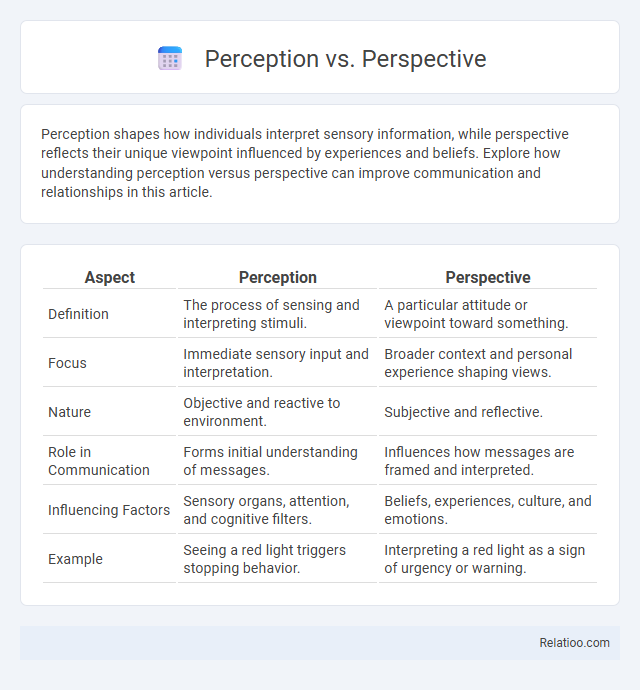Perception shapes how individuals interpret sensory information, while perspective reflects their unique viewpoint influenced by experiences and beliefs. Explore how understanding perception versus perspective can improve communication and relationships in this article.
Table of Comparison
| Aspect | Perception | Perspective |
|---|---|---|
| Definition | The process of sensing and interpreting stimuli. | A particular attitude or viewpoint toward something. |
| Focus | Immediate sensory input and interpretation. | Broader context and personal experience shaping views. |
| Nature | Objective and reactive to environment. | Subjective and reflective. |
| Role in Communication | Forms initial understanding of messages. | Influences how messages are framed and interpreted. |
| Influencing Factors | Sensory organs, attention, and cognitive filters. | Beliefs, experiences, culture, and emotions. |
| Example | Seeing a red light triggers stopping behavior. | Interpreting a red light as a sign of urgency or warning. |
Understanding Perception: Definition and Importance
Perception is the process by which your brain organizes and interprets sensory information to form an understanding of the environment, playing a critical role in how you experience reality. Unlike perspective, which relates to your viewpoint or attitude shaped by personal experiences, perception is more immediate and influenced by sensory input. Understanding perception is essential for improving communication and decision-making, as it determines how you interpret and react to the world around you.
Decoding Perspective: Meaning and Influence
Decoding perspective involves understanding how your viewpoint shapes the interpretation of information, influenced by experiences, beliefs, and emotions. Perspective guides the lens through which you perceive situations, differing from perception, which is the immediate sensory input, and interpretation, the cognitive process of making sense of that input. Recognizing this distinction enhances your awareness of biases and deepens comprehension in complex interactions.
Key Differences Between Perception and Perspective
Perception refers to the process by which individuals interpret sensory information from the environment, while perspective is the specific viewpoint shaped by personal experiences, beliefs, and attitudes. Key differences between perception and perspective lie in their roles; perception is about receiving and organizing sensory data, whereas perspective shapes how that data is understood and prioritized. Understanding these distinctions helps clarify how people can experience the same event differently based on sensory input versus cognitive framing.
How Perceptions Shape Our Reality
Perceptions, shaped by sensory input and cognitive processing, create the foundation of how individuals interpret reality, influencing emotions and decision-making. Perspective, encompassing personal experiences and cultural background, further filters and organizes these perceptions into coherent worldviews. Together, perception and perspective dynamically shape our understanding, demonstrating that reality is subjective and constructed through continuous mental interpretation.
The Role of Perspective in Decision Making
Perspective shapes decision making by influencing how information is interpreted and prioritized, while perception involves the sensory input that forms the basis for these interpretations. Different perspectives can lead to diverse conclusions even when perception remains constant, highlighting the subjective nature of human judgment. Understanding the role of perspective enables better conflict resolution and more informed, empathetic choices in complex situations.
Factors Affecting Perception and Perspective
Factors affecting perception include sensory input, past experiences, and expectations, which shape how you interpret information from your environment. Perspective is influenced by cultural background, personal beliefs, and social context, determining your viewpoint on situations or ideas. Understanding these factors helps improve self-awareness and communication, allowing you to better navigate differences between perception and perspective.
Perception vs Perspective in Communication
Perception in communication refers to how individuals interpret sensory information, shaping their understanding of messages based on experiences and context. Perspective involves the viewpoint or attitude shaped by personal beliefs, culture, and background that influences how communication is framed and received. Differentiating perception from perspective is crucial, as perception filters external inputs, while perspective shapes the internal lens through which communication is evaluated and responded to.
Impact on Relationships: Perception vs Perspective
Perception and perspective significantly impact relationships by shaping how you interpret others' actions and intentions. Perception involves the immediate sensory input and emotional response, while perspective reflects the broader context and experiences influencing your understanding. Misalignment between your perception and another's perspective often leads to misunderstandings, highlighting the need for empathy and open communication to strengthen relational bonds.
Shifting Perspectives to Change Perceptions
Shifting perspectives involves actively changing the way you interpret experiences, which directly influences your perceptions by altering the meaning assigned to those experiences. Your mindset shapes how sensory information is processed, while perspective provides the broader context that frames your interpretation. By consciously adopting new perspectives, you can transform perceptions, leading to enhanced understanding and improved decision-making.
Strategies to Broaden Perspective and Enhance Perception
Strategies to broaden perspective and enhance perception include actively seeking diverse viewpoints through cross-cultural experiences, engaging in reflective listening, and practicing mindfulness to increase awareness of personal biases. Cognitive flexibility exercises, such as challenging assumptions and considering alternative explanations, can deepen understanding and improve interpretative accuracy. Incorporating feedback from varied sources and utilizing critical thinking frameworks fosters a more nuanced comprehension of complex situations, thereby expanding both perspective and perception.

Infographic: Perception vs Perspective
 relatioo.com
relatioo.com